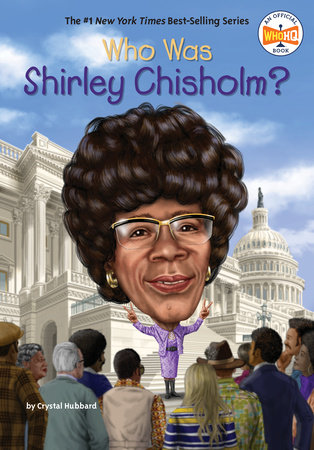Excerpt
Who Is Billie Jean King?
Who Is Billie Jean King? Twenty-nine-year-old Billie Jean King could hardly hear herself think as she waited in the locker room for the tennis match to start. More than thirty thousand spectators filled the Astrodome in Houston, Texas. They were shouting and whistling and stomping their feet. Every other tennis match that Billie Jean had played required that the audience be quiet and respectful. But this match on September 20, 1973, was different. It wasn’t a match in an official tennis tournament. Billie Jean wasn’t trying to win a trophy. It was a tennis match called the Battle of the Sexes. Ninety million people around the world were watching it on TV. And Billie Jean was playing to prove to her opponent, fifty-five-year-old Bobby Riggs, and the entire world that women were just as good at tennis as men!
At most tournaments, Billie Jean just walked from the locker room out onto the tennis court. But tonight, she was carried out onto the court on a fancy chair called a litter, the kind of chair that Queen Cleopatra, a ruler of ancient Egypt, might have used. The litter was covered in plastic gems and ostrich feathers, and it was carried by four men dressed in costumes meant to look like ancient Egyptians. As Billie Jean made her way to the tennis court, cameras flashed, a band played, and a famous sports announcer named Howard Cosell introduced her to the crowd. But at this point in her career, Billie Jean King didn’t really need an introduction. She was a top tennis player who was known for demanding big changes to the game of tennis.
Bobby Riggs, Billie Jean’s current opponent, had recently beaten thirty--year--old Margaret Court, Billie Jean’s main rival, in a tennis match. And he was sure he would beat Billie Jean just as easily. He believed that women weren’t as good as men at playing tennis—-or at doing anything. His entrance to the tennis court was just as showy as Billie Jean’s. He was in a rickshaw that was pulled by several young women. (A rickshaw is a chair on two large wheels that is pulled by a person or animal.)
Billie Jean had been practicing for this match for months. A lot was on the line. If she lost, people would agree with Bobby Riggs that women were not as good as men. If she won, the world might start to believe that women deserved to be respected and have the same rights as men.
Even though there was a lot riding on the match, Billie Jean felt calm and confident. She stepped down from the litter onto the tennis court. Showtime was over. It was time to play tennis.
Chapter 1 What’s Tennis? Billie Jean Moffitt was born on November 22, 1943, in Long Beach, California, a city that’s about a half-hour drive south of Los Angeles. Her father, Bill, was a firefighter, and her mother, Betty, was a homemaker. Billie Jean was the first child born to Betty and Bill Moffitt. Her brother, Randy, was born five years later.
Betty had thought she would name their daughter Michelle Louise. But Bill was called to serve in World War II before the baby was born. So in case Bill didn’t come back from the war, Betty decided that she should name their baby girl after him.
The Moffitts were a middle-class and an athletic family. Bill was a talented basketball player, and he had been offered a tryout for what is now a National Basketball Association (NBA) team. Betty was an excellent swimmer and a fast runner. Randy loved baseball and had announced to his family that he wanted to be a professional athlete. (He grew up to be a Major League Baseball [MLB] pitcher and played for the San Francisco Giants, Houston Astros, and Toronto Blue Jays.) When she was just four years old, Billie Jean and her dad started playing catch with a rubber baseball in the backyard. As she grew older, Billie Jean loved playing softball and football with the boys in the neighborhood. She even dreamed of playing professional football for the Green Bay Packers one day.
Billie Jean was a good athlete, and she did well in any sport she tried. Like her brother, she wanted to be a professional athlete when she grew up. But her parents were worried that their daughter would get hurt if she kept playing softball and football. And Billie Jean’s mother also felt that those sports weren’t very “ladylike.” She thought Billie Jean should switch to a sport that wasn’t so rough. She suggested that Billie Jean try golf or swimming. Billie Jean felt that golf was too slow, and she was actually too afraid of the water to try swimming.
Billie Jean also liked playing sports because it was a way for her to not feel so shy and awkward at school. She was bigger than all the girls, and even some of the boys, in her class. Because of that, she hated having to stand up in front of the class and give reports. But when Billie Jean was playing sports, her size was an advantage, and she forgot all about her insecurities.
One day in 1954, when Billie Jean was in the fifth grade, a friend named Susan Williams asked her if she wanted to play tennis. “What’s tennis?” Billie Jean replied. Susan explained what the game was, and Billie Jean agreed to join Susan at the country club her family belonged to. Although Billie Jean didn’t play very well, she loved that in tennis you could run, jump, and hit a ball—-the things that Billie Jean loved doing the most. When she got home, she asked her dad which sport he thought would be best for a girl to play long--term. “Well,” he said, “there’s swimming, golf, and tennis.” She was happy to hear that tennis was a sport that her parents would let her continue to play.
An Introduction to Tennis Tennis is played on a rectangular court with a net that divides the court into two halves. Players use rackets to hit a ball back and forth over the net. The goal of the game is to hit the ball over the net into the opponent’s half of the court so that the opponent is unable to return the ball. Tennis matches are either singles, with just two players; or doubles, with four players (two teams of two players each).
Scoring in tennis is based on points, games, and sets. Zero points is a score of 0 (also called love). One point is a score of 15, two points is 30, and three points is 40. When someone wins a point after they reach 40, they win the game! The first player to win six games wins a set. Women’s matches are usually two to three sets, and men’s matches are usually three to five sets.
Major Walter Clopton Wingfield from Great Britain published the first book of tennis rules in 1873. The first tennis championship took place four years later. It was held in a part of London, England, called Wimbledon. Now, the United Kingdom, Australia, France, and the United States each hold a major international tennis tournament each year. Together, the four tournaments are known as the Grand Slams. The Wimbledon tournament is the oldest Grand Slam event. A few weeks later, Billie Jean and Susan went to the public tennis courts in Long Beach. A tennis coach named Clyde Walker was giving free tennis lessons once a week. Billie Jean was excited to have a chance to play this new game again. She loved the sound of the racket hitting the ball and the power that made the ball sail back across the net.
After that first lesson with Clyde, Billie Jean knew she had found her sport. She was only ten, but when she got home, she told her mom, “I want to be the number one tennis player in the world!”
Chapter 2 Tennis and Life Aren’t Fair Billie Jean was determined to become a better player. She followed everything Clyde Walker taught her about tennis. With the eight dollars and twenty-nine cents she had saved while working odd jobs in her neighborhood, Billie Jean bought her very own wood racket with a grip in her favorite color—purple.
Billie Jean’s parents may not have believed that one day their daughter would ever reach the number one spot. But they loved that Billie Jean was willing to work hard to achieve her goal. They encouraged and supported her, and they drove her to coaching sessions and tournaments. Bill even put up a spotlight in the backyard so that Billie Jean could practice at night.
Billie Jean was learning as much as she could about the game of tennis. And she soon learned being a girl and not being rich meant that things weren’t always fair. Tennis was considered a sport that wealthy people played at country clubs. Billie Jean’s family was middle--class. They weren’t able to afford the expensive equipment and clothing that other kids had. Billie Jean wore clothing and tennis outfits that her mother made.
Boys Billie Jean’s age who were good tennis players received a lot more attention from coaches. They often got free meals before or after matches. When Billie Jean was in junior high, her principal refused to sign a permission slip that would allow her to compete in a tournament. She pleaded with the principal, who finally gave in. Billie Jean felt that if she had been a boy, the principal would not have thought twice about signing the permission slip. The mistreatment of someone based on their gender or sex is called sexism.
These things upset Billie Jean, but she didn’t let that stop her. She actually became more determined than ever to reach her goal. She also felt that it was her responsibility to help make tennis fairer and more equal. Billie Jean loved the game so much, and she wanted everyone to have an opportunity to play it if they wanted.
Billie Jean’s determination and hard work began to pay off. By 1958, she was ranked number two in the age fifteen--and--under Southern California Division. But Billie Jean knew that if she wanted to achieve her dream of being number one in the world, she would need more opportunities to improve her game. Unfortunately, her family couldn’t afford the costs of traveling to out-of-state tournaments. So when Billie Jean was offered the opportunity to take lessons with Alice Marble, a former tennis champion, she jumped at the chance.
Billie Jean was thrilled to be coached by a former number one player. Alice’s stories about her life and tennis matches fascinated Billie Jean, and Alice’s coaching made Billie Jean’s game get better and better. But Billie Jean and Alice didn’t always get along.
Billie Jean thought Alice was arrogant at times, and Alice thought Billie Jean was often selfish and boastful. Eventually, Alice stopped coaching Billie Jean. However, the time Billie Jean spent with Alice paid off. By the middle of 1960, Billie Jean had risen to number four in the rankings of all American female tennis players.
She was proving that her dream of being number one in the world might be possible. However, she still had to deal with people who made sexist remarks and comments about her size. A coach that Billie Jean respected told her that she would be a great tennis player someday. Not because she was a talented athlete—but because she was “ugly.” She could spend her time improving her game rather than focusing on boys, clothes, and makeup.
Billie Jean was shocked by this comment. It made her want to work even harder.
The next year, in 1961, Billie Jean had to miss her high school graduation so that she could play doubles (two teams of two players each) with her partner Karen Hantze at Wimbledon. Most people didn’t expect Billie Jean and Karen to get very far at the tournament. Everyone, including Billie Jean and Karen, was surprised when they made it to the final championship match—and won.












